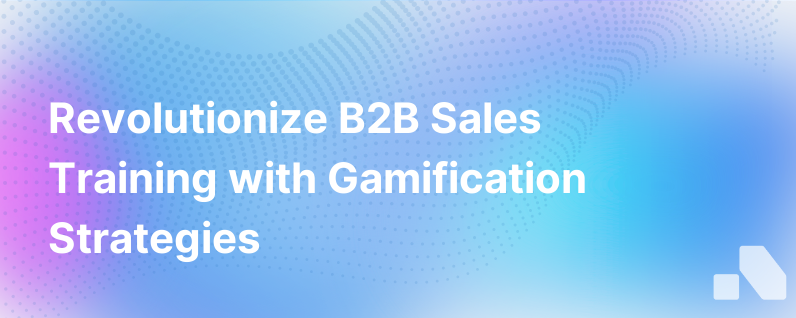Implementing Gamification in B2B Sales Training Programs
Published on November 26, 2023 by David Zhang
In today’s competitive business-to-business (B2B) landscape, sales training programs are vital in equipping sales teams with the skills needed to succeed. However, traditional approaches often evoke disinterest or lack the stickiness for meaningful knowledge retention. Gamification has emerged as a revolutionary way to reenergize sales training, making learning a more engaging, impactful, and continuous process.
Understanding Gamification in Sales Training
Gamification introduces game-like elements into sales training. This could involve leaderboards, point scoring, peer competition, performance tracking, and tiered rewards. The goal is to transform the learning experience from passive content consumption to active participation.
The Potential Benefits
When thoughtfully implemented, gamification can drive numerous advantages in the B2B sales training context:
-
Enhanced Engagement: Gamified experiences foster a more immersive and interactive learning environment.
-
Boosted Retention and CPU: By involving cognitive processes associated with playing and winning, information is retained more effectively.
-
Healthy Competition: By leveraging sales reps’ innately competitive natures, gamification can spur them to outperform their own benchmarks.
-
Insightful Data: Recording and analyzing actions within gamified trainings give managers a detailed understanding of each rep’s development.
-
Behavioral Nudging: Gamification can also shape and encourage preferred sales behaviors through structured incentives.
Best Practices for Incorporating Gamification
To create a successful gamified sales training program, consider these best practices:
-
Align with Learning Objectives: Every gamified element must have a purpose tied to the overarching training objectives.
-
Incorporate Realistic Scenarios: Role-playing customer scenarios and dealing with objections in a gamified format can heighten the learning experience.
-
Maintain Balance: The gamification should complement, not overwhelm, the essence of the training content.
-
Ensure Measurability: Establish clear metrics to track progress and correlate these with sales performance.
-
Keep It Fresh: Content and challenges should evolve to stay relevant and continue to motivate sales reps over time.
-
Promote Collaboration: Encouraging teamwork through gamification fosters camaraderie and shared learning.
Challenges to Anticipate and Overcome
Implementing gamification isn't without its challenges. These can range from potential cost implications to the risk of driving the wrong behaviors if incentives aren't aligned properly. There's also a need to ensure equity and fairness in the games to avoid demotivating less competitive team members.
To navigate these hurdles, organizations must:
-
Customize Thoughtfully: Ensure the gamified experience is tailored to the unique dynamics of your sales team and company culture.
-
Engage Sensibly: Allow participation to be conducive to learning without adding stress or pushing sales reps beyond their comfort zone.
-
Monitor Regularly: Keep a close watch on gamification outcomes and make data-driven adjustments where necessary.
Case Studies of Gamified Sales Training Success
Many companies have successfully integrated gamification into their sales training, driving engagement and knowledge retention. For instance, SAP's ‘Roadwarrior’ sales simulation provided a role-play environment that helped increase sales pipeline opportunities considerably. Other organizations, like Deloitte, have gamified their training modules to enhance engagement and interaction, resulting in higher course completion rates and better performance on knowledge assessments.
How to Measure the Effectiveness of Gamification
The power of any sales training initiative can be determined by its measurable outcomes. Key performance indicators (KPIs) for gamification should include:
-
Completion and Engagement Rates: Are sales reps interacting with and completing the gamified modules?
-
Retention Scores: Has knowledge retention improved as evidenced by tests or assessments?
-
Behavioral Changes: Are sales personnel exhibiting the desired behaviors in their sales practice post-training?
-
Sales Performance: Ultimately, an increase in sales figures will be the tangible proof of the efficacy of the gamified training program.
Conclusion: Gamification as a Strategic Sales Training Enhancement
In essence, gamification is not merely a novel trend; it’s a strategic enhancement to B2B sales training. It speaks directly to the innate competitive instincts and desires for mastery that drive sales professionals. When sensitively and sensibly integrated within the structure of sales training programs, gamification stands to transform the competency and performance of sales teams—turning learning into an engaging, interactive process that pays off in actual sales success.
For B2B organizations, the elevation of sales training through gamification holds the promise of driving sustained competitive advantage, ensuring that their sales forces remain agile, well-informed, and motivated to achieve more. As companies continue to discover the potential of this powerful educational modality, its application is likely to grow, evolve and become a bedrock of sales training programs aiming for transformative growth and measurable results.
Sources:
- How To Use Gamification To Improve Sales Training?
- A Fresh Perspective on Skill Development through Gamification
- Gamification in B2B Marketing: How Adding Fun Drives Lead Engagement
- How to Use Gamification to Improve Sales Training
- Why is gamification important in sales training?
- Gamification in B2B
- The Pros and Cons of Gamification
- The Benefits and Pitfalls of Gamification for Sales Team Training